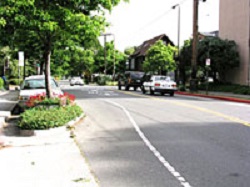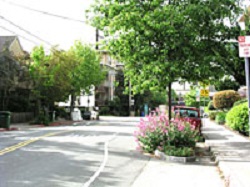Serpentine Street Design
Berkeley, California
Prepared by Laurie Actman, Patrick McMahon, and Henry Renski, University of North Carolina Highway Safety Research Center.
Information provided by Chuck DeLeuw, City of Berkeley, CA and Mourad Bouaouina, University of California at Berkeley.
Problem
Milvia Street was becoming more difficult for pedestrians and bicyclists to travel because of motorists using it to avoid traffic congestion on the parallel arterial routes between north Berkeley and downtown Berkeley and the University of California.
Background
Milvia Street is primarily a residential street with a large number of pedestrian traffic generators in close proximity to each other, including three daycare centers, a preschool, two elementary schools, a junior high school, and a city park. Milvia Street is located between two parallel arterials that provide an effective connection between north Berkeley and the downtown and University areas. As such, it was being used by motorists to avoid the traffic signals on those arterials. When combined with a difficult offset intersection at the corner of Delaware, this had created a difficult place where pedestrians, cyclists, parked cars and fast moving cars were mixing in a confined street. Further, a six-story office building was to be built nearby, which would increase traffic and make traveling along and across the street more difficult for pedestrians. After a considerable community effort to influence the office building project, the City received roughly $100,000 from the developers to prevent adverse impacts from the new traffic it would generate on Milvia.
Solution

Mid-block alignment shifting parallel parking from one side to the other.
A "slow street" plan was proposed by Urban Ecology, a local non-profit organization. The City retained transportation consultant Kenneth M. Bankston Associates to evaluate the Urban Ecology plan and alternatives. The report was used by City Public Works and Parks and Waterfront Department staff in coordination with local residents and street users to develop a recommended plan for a "slow street." With the mitigation funds from the developers and some additional city funds, the plan was implemented in 1989 to create the "Milvia Slow Street."
The design covers roughly six blocks of residential street in which 30 curb extensions/bulb-outs were placed to narrow the street at intersections and mid-block locations. These bulb-outs and planted islands create a serpentine design, which requires vehicles to slow and negotiate a winding path along the street.
Traffic calming improvements within the serpentine design were also intended to increase the aesthetic quality of the street. The curb extensions/bulb-outs and islands were landscaped and maintained by the local neighborhood residents. Some stamped concrete paving was installed near the new building to create a rumble strip for the entrance way, a decorative sign was erected notifying drivers that they are entering a calmed, residential neighborhood. Finally, the entire street was re-paved, speed humps were also installed on several blocks, the cracked sidewalks were redone, and ADA-compliant ramps were installed to make the sidewalk accessible to all pedestrians.
Results

Mid-block landscaped bulb-out with parallel parking.
As the first street in Berkeley to have speed humps installed, Milvia attracted considerable attention. There has been opposition from the fire department because speed humps may increase the difficulty of emergency response teams. Some bicyclists were concerned about the design because it did not provide a straight path for riding, it included speed humps, and removed previously-existing designated bicycle lanes. Drivers who used the street to cut-through between arterials also were unhappy with the project because they did not like driving over speed humps. Other residents were concerned because traveling over speed humps and other raised devices can jar vehicles and cause pain for disabled and elderly passengers.
In 1990, a year after implementation, graduate students at the University of California evaluated traffic speeds and volumes, including pedestrian and bicycle volumes. During the afternoon peak, the number of pedestrians increased from 63 to 93 (48 percent) on one block and from 42 to 95 (126 percent) on a second block of the street. An opinion survey was given to 18 people living within 3 blocks of the street and 14 other street users. Over 80 percent felt that the slow street improved pedestrian safety.
The study also found that daily motor vehicle volumes were lowered by the project from 540 to 441 (18 percent) on the first block and 500 to 399 (20 percent) on the second block. Post-project mean vehicle speeds along the street ranged from 14.6 mi/h to 16.1 mi/h at the speed humps and from 17.0 mi/h to 20.0 mi/h between the humps.
Though no official speed data have been collected recently along the Milvia "slow street", periodic observation shows that speeds continue to be slower than before the improvement, and motor vehicle traffic volumes are also lower. In addition, the street landscaping increased the attractiveness of the neighborhood. In 2002, Milvia was designated as a bicycle boulevard, one of a network of traffic-calmed streets featuring signs and pavement legends to facilitate bicycle travel.
Since the installation, Milvia Street resident and original supporter of the "slow street" concept, Kate Obenour, feels that the street has become much safer and that the number and severity of collisions has decreased dramatically. The success of Milvia Street has led to the installation of speed humps on over twenty other streets in Berkeley. However, after installation of over 150 speed humps, the Fire Department and members of the disabled community expressed concerns about adding more. As a result, a moratorium on speed hump construction has been in place, although other methods of traffic calming have and continue to be explored, such as speed tables with decreased vertical deflection.
Contact
Peter K. Hillier
Assistant City Manager for Transportation
2180 Milvia Street, 5th Floor
Berkeley, CA 94704
Phone: (510) 981-7000
Email: phillier@ci.berkeley.ca.us
References
Bankston, Kenneth, and Associates, "Final Report -- Proposed Slow Street Design Evaluation in Berkeley, California," February 1988.
Bouaouina, Mourad and Robinsion, Bruce. "An Assessment of Neighborhood Traffic Calming: Milvia Slow Street in Berkeley, California," Submitted to Professor E. Deakin, University of California at Berkeley, Fall 1990.

